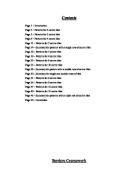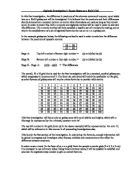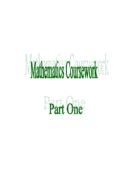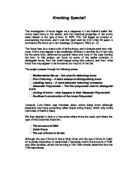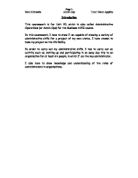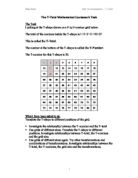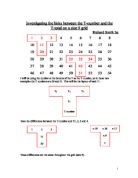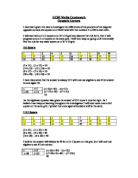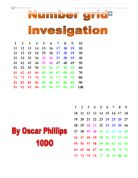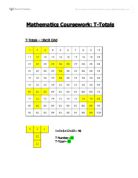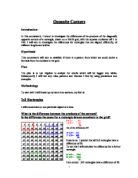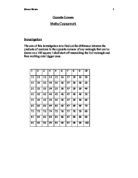opposite corners
Maths Coursework: Opposite Corners Opposite Corners: Introduction: My algebra coursework is about opposite corners in a square in a number grid. The top right and the bottom left numbers are multiplied and the same is done with the top left and bottom right numbers. The difference is calculated between the 2 products and the answer is used to find a pattern. The size of the square will be changed, 2x2, 3x3 and 4x4, to see whether the answers left will help to determine whether or not there is a pattern. 0x10 Grid: I am starting off by using a 10x10 and within this grid I will outline 2x2 squares, 3x3 squares and 4x4 squares. With these squares I will work out the opposite corners in order to see whether or not there is a pattern. 2 3 4 5 6 7 8 9 0 1 2 3 4 5 6 7 8 9 20 21 22 23 24 25 26 27 28 29 30 31 32 33 34 35 36 37 38 39 40 41 42 43 44 45 46 47 48 49 50 51 52 53 54 55 56 57 58 59 60 61 62 63 64 65 66 67 68 69 70 71 72 73 74 75 76 77 78 79 80 81 82 83 84 85 86 87 88 89 90 91 92 93 94 95 96 97 98 99 00 2x2 Squares: 2 3 4 5 6 7 8 9 0 1 2 3 4 5 6 7 8 9 20 21 22 23 24 25 26 27 28 29 30 31 32 33 34 35 36 37 38 39 40 41 42 43 44 45 46 47 48 49 50 51 52 53 54 55 56 57 58 59 60 61 62 63 64 65 66 67 68 69 70
I am going to investigate how changing the number of tiles at the centre of a pattern, will affect the number of border tiles I
Contents Page 1 ~ Introduction Page 2 ~ Patterns for 2 centre tiles Page 5 ~ Patterns for 3 centre tiles Page 8 ~ Patterns for 4 centre tiles Page 11 ~ Patterns for 5 centre tiles Page 14 ~ Summary for patterns with a single row of centre tiles Page 16 ~ Patterns for 4 centre tiles Page 19 ~ Patterns for 6 centre tiles Page 22 ~ Patterns for 8 centre tiles Page 25 ~ Patterns for 10 centre tiles Page 28 ~ Summary for pattern with a double row of centre tiles Page 30 ~ Summary for single and double rows of tiles Page 31 ~ Patterns for 6 centre tiles Page 34 ~ Patterns for 9 centre tiles Page 37 ~ Patterns for 12 centre tiles Page 40 ~ Patterns for 15 centre tiles Page 43 ~ Summary for patterns with a triple row of centre tiles Page 44 ~ Conclusion Borders Coursework Introduction For my experiment I am going to investigate how changing the number of tiles at the centre of a pattern, will affect the number of border tiles I will need. I will do this to find patterns and a formula, to link back to each set of patterns. Each formula will be tested by using a larger border, but with the same number of centre tiles, this will ensure my formula is correct. I will then try to find a general formula, that will enable me to predict the border for any size centre tiles. I will also do the same for the total tiles in the pattern. Key N ~ Pattern B ~ Outer border
maxi products
GCSE Maths Coursework - Maxi Product Introduction In this investigation, I am going investigate the Maxi Product of numbers. I am going to find the Maxi Product for selected numbers and then work out a general rule after individual rules are worked out for each step. I am going to find the Maxi Product for double numbers, I will find two numbers which added together equal the number selected and when multiplied will equal the highest number possible that can be retrieved from two numbers multiplied together. I am also going to find the Maxi Product for triple numbers, I will find three numbers which added together equal the number selected and when multiplied will equal the highest number possible that can be retrieved from three number multiplied together. And finally, I am going to find the Maxi Product for quadruplet numbers, I will find four numbers which added together equal the number selected and when multiplied will equal the highest number possible that can be retrieved from four numbers multiplied together. After working out the individual rules for these three sectors of numbers, I will then work out the general rule for any amount of numbers it can be split into. For example, it can be split up into five numbers and I will be able to find the Maxi Product of any number given by splitting it up into five numbers. I will be using whole numbers, decimal numbers
For my investigation I will be finding out patterns and differences in a number grid.
Introduction For my investigation I will be finding out patterns and differences in a number grid. An example of a number grid that I am going to use for my investigation is shown below. Columns 2 3 4 5 6 7 8 9 0 1 2 3 4 5 6 7 8 9 20 21 22 23 24 25 26 27 28 29 30 31 32 33 34 35 36 37 28 39 40 41 42 43 44 45 46 47 48 49 50 51 52 53 54 55 56 57 58 59 60 61 62 63 64 65 66 67 68 69 70 71 72 73 74 75 76 77 78 79 80 81 82 83 84 85 86 87 88 89 90 91 92 93 94 95 96 97 98 99 00 Rows As you can see I will draw a box on the number grid and multiply the top left number with the bottom right number in the box. I will then do the same for the top right and the bottom left number. Once I have the sum for each multiplication I will then find the difference between the two calculations. I will different size of boxes e.g. 2x2 and 3x3; these numbers represent the number of numbers there are across the side of box and on top of the box. An example of this would be 4x4 means there is 4 numbers on the side and 4 numbers on the top as shown below. 2 3 4 1 2 3 4 21 22 23 24 31 32 33 34 Multiply the top left number with the bottom right number then do the same, multiply the bottom left number with the top right number. After this take both calculations and minus them both from
Algebra Investigation - Grid Square and Cube Relationships
Algebraic Investigation 1: Square Boxes on a 10x10 Grid In this first investigation, the difference in products of the alternate corners of a square, equal-sided box on a 10x10 gridsquare will be investigated. It is believed that the products and their differences should demonstrate a constant pattern no matter what dimensions are used; as long as they remain equal. In order to prove this, both a numeric and algebraic method will be used in order to calculate this difference. The numeric method will help establish a baseline set of numbers for testing, and to help in the establishment of a set of algebraic formulae for use on an n x n gridsquare. In the example gridsquare below, the following method is used in order to calculate the difference between the products of opposite corners. (a) (b) (c) (d) Stage A: Top left number x Bottom right number = (a) multiplied by (d) Stage B: Bottom left number x Top right number = (c) multiplied by (b) Stage B - Stage A: (c)(b) - (a)(d) = The difference The overall, 10 x 10 grid that is used for the first investigation will be a standard, cardinal gridsquare, which progresses in increments of 1. The formulae calculated will mainly be applicable to this grid, as other formats of gridsquares will require others formulae to provide valid results. 2 3 4 5 6 7 8 9 0 1 2 3 4 5 6 7 8 9 20 21 22 23 24 25
Mathematical Coursework: 3-step stairs
91 92 93 94 95 96 97 98 99 00 81 82 83 84 85 86 87 88 89 90 71 72 73 74 75 76 77 78 79 80 61 62 63 64 65 66 67 68 69 70 51 52 53 54 55 56 57 58 59 60 41 42 43 44 45 46 47 48 49 50 31 32 33 34 35 36 37 38 39 40 21 22 23 24 25 26 27 28 29 30 1 2 3 4 5 6 7 8 9 20 2 3 4 5 6 7 8 9 0 In order to understand the relationship between the stairs total and the position of the stairs shape on the grid. Foremost, I needed to distinguish if the stair total had something in common. As I believe this would enable me to find a pattern, which would eventually develop into an algebraic equation. To be able to do this I had to experiment with the grid, by shifting the 3-step stairs into different direction et cetera. In addition I would've seen if the pattern and algebraic equation would've work in different size grid such as 9cm by 9cm or in different size stair shape such as 4- step stairs. In order to find the pattern I will have to draw various grids, this will enable me to eventually discover the pattern. Firstly, for my first experimental grid I decide the start in the bottom corner and randomly select a few other 3-step stairs. 91 92 93 94 95 96 97 98 99 90 81 82 83 84 85 86 87 88 89 80 71 72 73 74 75 76 77 78 79 70 61 62 63 64 65 66 67 68 69 60 51
Knotting Special!
Knotting Special! The investigation of knots began as a response to Lord Kelvin's belief that atoms were knots in the aether, and that chemical properties of the atoms were related to the type of knot. In 1877, P.G. Tait began an attempt at enumerating the knots, and it took him (and work by C.N. Little) 23 years to enumerate the knots up to ten crossings. (Livingston, 1993, p1-2) The focus then, is to create a list of all the knots, and to include each knot only once. A knot may appear to be completely different to another, but in fact may be the same knot, deformed by several twists and turns of the rope forming the knot. In this project, we focus on some of the earlier attempts to distinguish knots, from the trivial looped string (the unknot), and from other knots that may appear to be the same, but may not in fact be. The project passes through the following areas: Reidermeister Moves - the rules for deforming knots Knot Colouring - A basic attempt at distinguishing knots Labelling mod p - A more elaborate 'colouring' procedure Alexander Polynomials - The first polynomial used to distinguish knots Joining of knots - what happens to their Alexander Polynomials Kauffman's construction of the Jones Polynomial However, Lord Kelvin was mistaken about atoms being knots (although physicists now have something called Super-string theory, which may evoke memories of
admin in business
Introduction This coursework is for Unit 20, which is also called Administrative Operations (or Admin Ops) for the Business AVCE course. In this coursework, I have to show I' am capable of showing a variety of administrative skills for a project of my own choice. I have chosen to base my project on the Old Bailey. In order to carry out my administrative skills, I had to carry out an activity such as, setting up and participating in an away day trip to an organisation for at least six people, in which I' am the key administrator. I also have to show knowledge and understanding of the roles of administrators in organisations. In this coursework I' am required to work in a group of people that have specific roles in the group and plan and organize (or administer) our own event for AVCE Business Studies Year 2, unit 20 - Admin Ops. Our event has to be well planned and multi-layered, as this will allow each individual in the group to act out their role. My group is built up of 6 people. They are, Rachel, Chris, Sophie, Asif, Ashraf and me. We have all worked together in Unit 1 (Business At Work) and have all obtained experience of producing information. Examples are in, Unit 3, 4 and 10 (Marketing, HR and Customer Service). We all set each other positions or roles in the group in order to get our event started up. Below are my group's roles/positions. * Rachel - Boss *
The T-Total Mathematics Coursework Task.
The T-Total Mathematics Coursework Task The Task Looking at the T-shape drawn on a 9 by 9 number grid below. The total of the numbers inside the T-shape is 1+2+3+11+20=37 This is called the T-Total. The number at the bottom of the T-shape is called the T-Number. The T-number for this T-shape is 20. 2 3 4 5 6 7 8 9 0 1 2 3 4 5 6 7 8 9 20 21 22 23 24 25 26 27 28 29 30 31 32 33 34 35 36 37 38 39 40 41 42 43 44 45 46 47 48 49 50 51 52 53 54 55 56 57 58 59 60 61 62 63 64 65 66 67 68 69 70 71 72 73 74 75 76 77 78 79 80 81 What I have been asked to do Translate the T-shape to different positions of the grid. * Investigate the relationship between the T-number and the T-total * Use grids of different sizes. Translate the T-shape to different positions. Investigate relationships between T-total, the T-numbers and the grid size. * Use grids of different sizes again. Try other transformations and combinations of transformations. Investigate relationships between the T-total, the T-numbers, the grid size and the transformations. The Method I have chosen I will follow my plan below while following the task and customizing it to achieve maximum marks. * I will first draw out one or two 9 by 9 number grids. Then I will fill in T-shapes until I see a pattern, each shape will be in a different colour
Investigating the links between the T-number and the T-total on a size 9 grid
Investigating the links between the T-number and the T-total on a size 9 grid Richard Smith 5? 2 3 4 5 6 7 8 9 0 1 2 3 4 5 6 7 8 9 20 21 22 23 24 25 26 27 28 29 30 31 32 33 34 35 36 37 38 39 40 41 42 43 44 45 46 47 48 49 50 51 52 53 54 I will be using the number at the bottom of the T as the T-number, so in these two examples the T-numbers are 20 and 51. This will be the layout of each T: - T2 T3 T4 T1 T-number Take the differences between the T-number and T1, 2, 3 and 4. n-19 n-18 n-17 n-9 n 2 3 1 20 These differences are the same throughout the grid (size 9). Examples n-19 n-18 n-17 n-9 n 32 33 34 42 51 n-19 n-18 n-17 n-9 n 6 7 8 26 35 If you take all the differences, which add up to be -63 and take that from 5 (the amount of numbers in one T) multiplied by the T-number, it gives you the T-total. Here is the formula: - 5n-63=T-total I will now test this formula using some of the T shapes above. 6 7 8 26 35 2 3 1 20 32 33 34 42 51 5n-63 = T-total 5(20)-63 = T-total 37 = T-total Also: + 2 + 3 + 11 +20 = 37 5n-63 = T-total 5(51)-63 = T-total 92 = T-total Also: 32 + 33 + 34 + 42 + 51 = 192 5n-63 = T-total 5(35)-63 = T-total 12 = T-total Also: 6 + 17 + 18 + 26 + 35 = 112 As I have proved, the formula is correct for the T shape in a grid size of 9.




